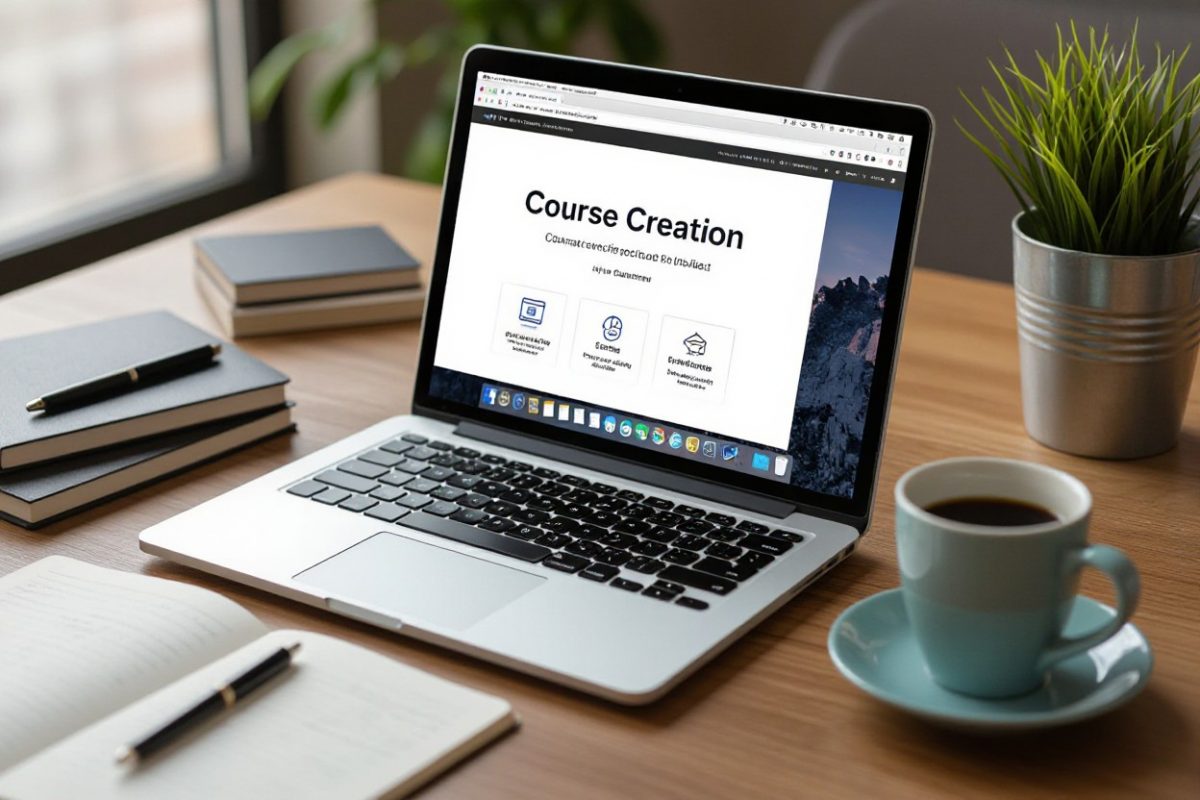Most aspiring course creators face challenges when starting their first mini course, but with the right approach, you can streamline the process and deliver real value to your students. This guide walks you through every step of creating a focused, actionable mini course on Zenler, helping you connect your content seamlessly from lead magnet to paid offering. By following clear strategies and using accessible tools, you’ll build a professional, engaging learning experience that supports your growth as an online educator.
Key Takeaways:
- Keep your mini course focused on a specific topic that connects directly to your lead magnet to maintain audience interest and improve sales.
- Design 3-5 lessons with clear learning objectives and actionable content to provide value without overwhelming students.
- Use affordable tools like Canva Pro for editing and Handbrake for video compression to create and manage quality course content efficiently.
- Price your mini course under $20 to make it accessible and position it as an entry point to your broader paid offerings.
- Avoid overcomplicating your course content and perfectionism; start with a solid foundation and improve based on feedback over time.
Identifying Lucrative Niches and Topics
Researching Market Demand
Explore platforms like Google Trends, Udemy, and social media groups to uncover what topics are currently resonating with learners. Look for search volumes, popular course categories, and gaps where the demand exceeds the available solutions. For example, personal productivity courses consistently show high interest, especially in topics like time-blocking and habit formation, signaling a strong market potential for mini courses in those areas.
Aligning with Your Expertise
Focusing on your existing skills and knowledge ensures authenticity and confidence in your content delivery. Choose a topic you’ve mastered—whether it’s graphic design, nutrition coaching, or freelance writing—and that naturally extends from your lead magnet. This alignment shapes a cohesive learning path that your audience will appreciate and trust.
Diving deeper into your expertise allows you to carve out a niche where you truly add value. If you’ve built a following through content on, say, sustainable living, developing a mini course on eco-friendly home hacks leverages your credibility and provides a logical next step. This targeted approach helps differentiate your course from broad, generic offerings and attracts motivated learners ready to invest in your specialized knowledge.

Crafting a Value-Driven Course Proposition
Defining the Course Outcome
Pinpoint exactly what your students will achieve by the end of your mini course. Defining a clear, measurable outcome keeps your lessons focused and benefits your marketing efforts. For example, instead of a vague promise like “learn stress management,” specify “reduce daily stress by applying three proven breathing techniques.” This sharp focus both motivates learners and guides your content creation.
Understanding Your Audience’s Pain Points
Addressing real challenges your audience faces makes your course immediately relevant and compelling. Dive into specific problems that your ideal student struggles with, such as time scarcity, lack of motivation, or confusion over where to start. Offering solutions targeted to these pain points transforms your course from just information to a practical toolkit your students need.
Exploring your audience’s pain points goes beyond guessing. Use tools like surveys, social media polling, or direct conversations to gather precise insights. For instance, if you teach productivity, discover whether your audience is overwhelmed by task lists or distracted by technology. Tailor your lessons to resolve the top 2-3 pain points to maximize impact, ensuring each session offers a targeted solution that feels personal and actionable.
Structuring Your Mini Course for Maximum Impact
Focusing on Key Learning Objectives
Pinpointing clear, concise learning objectives ensures each lesson delivers measurable value. Define what students will know or be able to do by the end of the course, avoiding vague goals. For example, instead of “understand stress,” aim for “identify three personal stress triggers and apply two immediate relief techniques.” These targeted outcomes guide your content and give students tangible takeaways that reinforce progress and satisfaction.
Designing a Logical Flow of Content
Arrange your lessons so each builds naturally on the previous one, creating a seamless learning journey. Progress from foundational concepts to actionable strategies, avoiding abrupt topic jumps. This not only sustains engagement but helps learners retain information more effectively as they connect new ideas with what they’ve already mastered.
Diving deeper, start by mapping out the vital components of your topic and ranking them by complexity or dependency. For instance, if your mini course focuses on stress management, begin with identifying stress triggers before moving to coping mechanisms, then end with long-term lifestyle adjustments. Transitions between lessons can be reinforced with quick recap points or mini assignments that help solidify understanding before advancing. The logical structure also supports pacing—shorter introductory lessons set students up for slightly longer, more detailed lessons later, maintaining momentum without overwhelming them.
The Role of Lead Magnets in Course Creation
Building a Seamless Connection
Ensure that your mini course picks up directly where your lead magnet leaves off, extending the value your audience already recognizes. For instance, if your lead magnet is a checklist that identifies stress triggers, your course could offer step-by-step techniques to manage those stressors effectively. This logical progression keeps your audience engaged and emotionally invested, increasing the likelihood they’ll enroll.
Integrating Feedback for Improved Content
Collecting and applying student feedback after launching your mini course helps fine-tune the content, pacing, and delivery. Early feedback can highlight unclear lessons or missing information that, once addressed, elevates the learning experience and boosts positive reviews, fostering stronger trust and repeat customers.
Beyond basic tweaks, gathering qualitative feedback allows you to identify patterns in student challenges or misconceptions. For example, if multiple students report difficulty applying a particular stress management technique, you might add a supplementary video or worksheet clarifying that step. Quantitative data like completion rates per lesson can also reveal where students lose interest, signaling opportunities to shorten or adjust content. Over time, these refinements create a polished, user-centered mini course that resonates deeply and consistently converts leads into paying students.
Developing Engaging Lesson Formats
Traditional vs. Interactive Content
Traditional lessons often rely on lectures or slide presentations, providing clear, structured information, which works well for straightforward topics. However, blending in interactive elements like quizzes, polls, and exercises increases engagement by actively involving your students. For example, embedding short reflection prompts or quick tasks after each lesson encourages application, making learning stickier and more practical without overwhelming the flow of your mini course.
Choosing the Right Medium: Video, Audio, or Text
Different formats serve different learning styles and content types. Video tends to be the most engaging and personal, offering visual cues and demonstrations, whereas audio works well for on-the-go lessons like guided meditations or interviews. Text-based lessons suit topics requiring detailed explanations, worksheets, or step-by-step guides. Selecting the right medium depends on your content’s nature and your audience’s preferences.
Video content shines for mini courses focusing on skills demonstration, such as cooking techniques or stress relief exercises, where visual and verbal cues enhance comprehension. Audio formats provide accessibility to busy learners who prefer consuming content during commutes or workouts, expanding your reach. Meanwhile, text allows for easy reference and deeper reflection, ideal in courses emphasizing theory or checklists. Combining these mediums within your mini course can maximize impact—like pairing short videos with downloadable PDFs—catering to diverse learner preferences and improving knowledge retention.

Technical Tools to Elevate Your Course Quality
Equipment Essentials for Beginners
Affordable options like a USB condenser microphone (e.g., Blue Yeti around $130) and a ring light ($30-$50) can dramatically improve your audio and lighting without breaking the bank. A smartphone with a good camera or an entry-level DSLR paired with a simple tripod provides stable, clear video. Starting with these basics lets you focus on content while maintaining professional quality that keeps students engaged.
User-Friendly Editing Software Choices
Intuitive editing platforms such as Canva Pro offer simple drag-and-drop video editing for about $12 per month, perfect for trimming clips and adding text overlays. Free options like DaVinci Resolve provide more advanced tools if you want to invest time learning. These tools help polish recordings quickly, enhancing viewer experience without requiring a technical background.
Canva Pro stands out for ease of use, especially if you’re new to video editing. Its template-based system streamlines adding titles, transitions, and branding consistent with your course material. Meanwhile, DaVinci Resolve combines professional-grade features like color grading and audio mixing with a free version robust enough for detailed editing projects. Both support exporting in various formats optimized for platforms like Zenler, ensuring your videos load smoothly and maintain clarity under size limits.
Effective Pricing Strategies to Attract Students
Understanding Low-Ticket Pricing
Low-ticket pricing usually means setting your mini course under $20, making it an easy purchase decision for your audience. This price point builds trust, attracts more students, and serves as an entry point into your broader course offerings. Courses focused on niche skills—like a 4-part guided meditation series—often price between $15 to $20, balancing accessibility with perceived value, and encouraging repeat business through upsells or advanced courses.
Setting Value-Based Price Points
Aligning your course price with the value delivered ensures students feel they’re getting a worthwhile investment. For example, if your mini course offers actionable techniques that can save users hours per week, pricing it closer to $20 reflects that tangible benefit better than an arbitrary lower fee. Value-based pricing also allows you to position your course competitively within your niche.
Calculating value-based prices involves identifying the primary outcomes your students achieve, then estimating the time or money saved through those results. If teaching stress management cuts down daily anxiety enough for users to improve sleep or productivity, that improved quality of life justifies a higher price within the low-ticket range. Case studies show mini courses priced with clear outcomes in mind tend to convert better, as buyers perceive the cost as an investment rather than an expense.
Common Missteps in Mini Course Development
Avoiding Overcomplication: Less is More
Trying to pack too much into your mini course dilutes its impact and overwhelms both you and your students. Stick to 3-5 focused lessons that align tightly with your lead magnet’s topic. For example, if your lead magnet identifies stress triggers, concentrate your mini course on just a few practical techniques rather than an exhaustive mindfulness curriculum. This keeps your course manageable, actionable, and far more appealing as a quick, effective learning experience.
Battling Perfectionism in Content Creation
Waiting for your course to be flawless before launching often leads to unnecessary delays and lost momentum. Launch with “good enough” content that covers your core lessons and refine it based on real student feedback. Early users appreciate authentic, functional learning over polished but inaccessible material.
Many creators stall trying to perfect every video edit or script detail, but perfectionism paralysis can stall your progress indefinitely. It’s smarter to focus on delivering clear learning objectives and actionable steps, then iterate. For instance, one course creator found that after launching a mini course at 80% finished quality, user suggestions highlighted areas for improvement, leading to better engagement and smoother updates. Tracking feedback through surveys or direct messages on platforms like Zenler helps you evolve your course efficiently while keeping your audience engaged.
Ensuring Cohesion Between Free Content and Paid Course
Crafting a Natural Progression
Link your mini course directly to the problem your lead magnet introduces, building on what your audience already values. For example, if your lead magnet helps identify stress triggers, follow up with actionable stress management techniques in your course. This logical sequence encourages learners to view your paid offering as the next imperative step, making the transition seamless and boosting enrollment rates.
Leveraging Testimonials for Credibility
Showcasing feedback from previous students who experienced clear benefits reinforces trust and validates your mini course’s impact. Positive testimonials build confidence by demonstrating real-world results, influencing hesitant prospects to invest in your offering.
Including detailed testimonials drives conversion by providing concrete examples of student success. Highlight specifics like measurable outcomes—such as “reduced stress levels by 30% after applying techniques from the course” or “improved productivity within two weeks.” Video testimonials increase authenticity, showing genuine enthusiasm and personal stories. Encourage early adopters to share their experiences soon after course completion so their fresh excitement translates into compelling social proof. Strategically place testimonials throughout your sales page and emails to continuously affirm your course’s value and reliability.

Launching Your Mini Course: Steps to Success
Building Anticipation Through Pre-Launch Marketing
Generating excitement before your mini course goes live can significantly boost enrollment. Engage your audience with teaser content, sneak peeks, or exclusive early-bird discounts shared via email or social media. Use countdown timers and highlight clear benefits tied to your lead magnet to create a sense of urgency and relevance. Short video clips or behind-the-scenes looks add a personal touch that connects and motivates prospective students to act once your course launches.
Utilizing Zenler’s Features for a Smooth Launch
Leveraging Zenler’s built-in marketing and automation tools simplifies your course launch. You can set up automated email sequences to welcome, nurture, and convert leads seamlessly. Zapier integrations allow for smooth connectivity with payment gateways and CRM systems, while the customizable landing pages ensure your course landing hits the right tone and messaging for your audience. These features minimize manual work, letting you focus on engaging students and growing your course income.
Zenler’s platform goes beyond hosting by providing detailed analytics so you can track sales trends and student engagement in real time. The integrated affiliate system opens doors to collaborative promotions, incentivizing others to spread the word about your mini course. With easy-to-configure coupons, flexible pricing options, and automated drip content, you can tailor the launch experience to fit your strategy while maintaining control over every touchpoint. These capabilities create a streamlined launch environment that supports scaled growth without added complexity.
Analyzing Course Performance and Student Feedback
Leveraging Analytics for Continuous Improvement
Tracking completion rates, quiz scores, and engagement metrics gives you a detailed view of how your mini course performs. For example, if a significant drop-off occurs during Lesson 3, you can revisit that content to improve clarity or pacing. Platforms like Zenler provide built-in analytics dashboards that highlight these trends, letting you make data-driven tweaks that enhance learner satisfaction and conversion rates over time.
Collecting and Implementing Student Insights
Gathering direct feedback through surveys, course comments, and one-on-one conversations reveals what resonates with your audience and where gaps remain. Open-ended questions often surface specific suggestions that quantitative data misses, helping you tailor content updates or spot new topic ideas aligned with learner needs.
Diving deeper into student insights means committing to active listening and responsive iteration. For instance, if multiple learners mention confusion over a particular concept or request additional examples, integrating those changes boosts clarity and engagement. Incorporate a mix of anonymous surveys and personal check-ins to capture honest opinions. Monitoring this feedback regularly creates a feedback loop that keeps your course evolving alongside your students, improving retention and word-of-mouth promotion. Case studies show that courses adjusted based on student input see a 20-30% rise in completion rates within just a few months.
Expanding Your Course Portfolio
Transitioning from Mini Course to Full Offerings
After delivering a high-value mini course, use feedback and engagement data to identify which topics resonate most with your audience. Develop these into comprehensive courses by expanding lesson depth, adding activities, and incorporating varied content formats like workbooks or live sessions. This progression not only deepens student learning but also creates a natural upsell path from your initial offering, increasing lifetime customer value without overwhelming your existing audience.
Scaling Your Brand with Additional Courses
Building multiple courses around complementary topics broadens your reach and strengthens your brand authority. Launching courses that address different pain points within your niche can capture diverse segments of your market, positioning you as a go-to expert. Many successful creators expand from one mini course into a portfolio of three to five focused offerings, each priced to attract different buyer personas and learning preferences.
Besides diversifying revenue streams, additional courses create cross-promotional opportunities within your ecosystem. For example, a fitness instructor might start with a mini course on stress management, then introduce full-length programs on nutrition, workout routines, and mindfulness practices. This layered approach leverages your existing audience’s trust while attracting new learners interested in specific subtopics. Careful planning of course release schedules and thematic consistency helps maintain momentum, encouraging repeat enrollments and boosting your brand’s recognition across platforms.
Building a Community around Your Courses
Engaging with Students Post-Course
Keep the conversation going beyond course completion by regularly checking in through email updates or course platform announcements. Prompt students to share their progress, ask questions, or provide feedback to maintain momentum and deepen their connection to your content. Quick responses and personalized encouragement can boost satisfaction and turn one-time learners into loyal followers eager for your next offering.
Fostering a Supportive Learning Environment
Encourage interaction through discussion boards or dedicated social media groups where students feel comfortable sharing ideas and challenges. Highlight success stories and facilitate peer-to-peer support to foster a sense of belonging. This kind of environment enhances motivation and creates a vibrant learning community that extends the value of your mini course.
Creating a supportive learning environment involves more than just opening a forum; it means cultivating a culture where members feel safe and valued. You might establish clear community guidelines to promote respectful communication and actively moderate discussions to keep them productive. Incorporate interactive elements like weekly challenges or live Q&A sessions to increase engagement. Data shows that courses with strong community support see higher completion rates—sometimes up to 50% more—because learners feel accountable and inspired by their peers. This kind of ongoing engagement ultimately drives both student success and your course’s reputation.
Final Words
As a reminder, creating your first mini course on Zenler is a practical way to share your expertise and engage your audience with focused, valuable content. By keeping your lessons clear and actionable, and aligning your course naturally with your lead magnet, you set yourself up for success. Use simple tools and reasonable pricing to make your course accessible while growing your reach. With consistent effort and attention to your students’ needs, you can build a rewarding course creation business that expands over time.
FAQ
Q: How do I choose the right topic for my mini course?
A: Select a topic that is focused and directly connected to your lead magnet. This ensures a smooth transition for your audience from the free resource to the paid course. Focus on a specific problem or skill that your audience wants to learn, and keep the scope narrow to provide clear, actionable value.
Q: What is the ideal length and structure for lessons in a mini course?
A: Mini courses generally work best with 3 to 5 lessons, each designed around one learning objective. Aim for lessons to be around 15-20 minutes long to keep students engaged while delivering meaningful content that they can apply immediately.
Q: What tools do I need to record and edit my mini course videos?
A: You don’t need expensive equipment to create quality videos. A good smartphone or basic camera, combined with affordable software like Canva Pro for editing and free tools like Handbrake for compressing your files, can produce professional results suitable for uploading to most course platforms.
Q: How should I price my mini course to attract students?
A: Mini courses are usually priced as low-ticket offers, typically under $20. Pricing should reflect the course’s focused content and value. For example, specialized mini courses with 3-5 lessons often sell well in the $15-$20 range, making them accessible while providing meaningful outcomes for learners.
Q: What common mistakes should I avoid when creating my mini course?
A: Avoid overloading your course with too much information or trying to perfect every detail before launch. Focus on delivering clear, actionable lessons that provide quick wins for students. Also, ensure your mini course aligns with your lead magnet to maintain a coherent learning journey and maximize sales.

